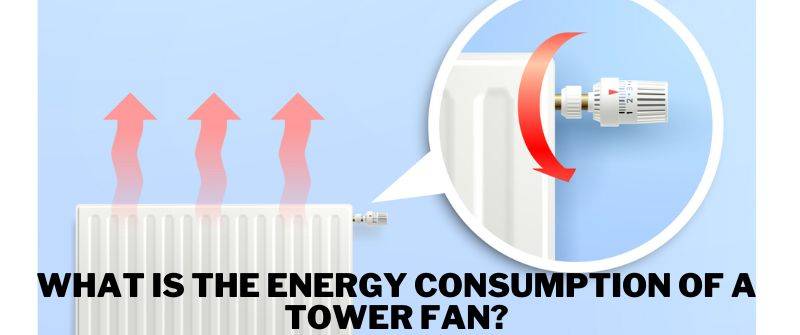A tower fan is a type of portable fan that is tall and slender, making it easy to fit in narrow spaces and providing a wider coverage area for airflow.
Tower fans are a popular choice for cooling small rooms or providing a refreshing breeze in larger spaces, as they take up less floor space than traditional box fans or standing fans.
Tower fans vary in their energy usage, depending on their size and features. In general, tower fans use less energy than other types of fans, such as ceiling fans or whole-house fans; because they are smaller and typically use a more efficient type of motor.
What Is the Energy Consumption of a Tower Fan?
How to determine energy usage:
To determine the energy usage of a specific tower fan, you can look for its energy consumption rating, which is usually listed in watts (W). This rating represents the amount of electricity the fan uses when it is operating at full speed.
For example, a tower fan that has an energy consumption rating of 50 W would use 50 watts of electricity when it is running at full speed.
To calculate the cost of operating the fan, you can multiply the energy consumption rating by the number of hours you use the fan, and then divide the result by 1000 to convert it to kilowatt-hours (kWh).
An example, if you use a tower fan with a 50 W rating for 4 hours per day, it would use 200 watt-hours of electricity per day or 0.2 kWh.
To put this in perspective, the average American household uses about 901 kWh of electricity per month, so a tower fan with a 50 W rating that is used for 4 hours per day would only contribute about 0.73% to the monthly electricity usage.
It’s also worth noting that tower fans typically have multiple speed settings, and the energy consumption will be lower at lower speeds. So, if you use the fan on a lower setting, it will use even less energy.
In general, tower fans tend to be more energy efficient than other types of fans due to their compact size and streamlined design. However, the actual amount of energy a tower fan uses can range from as little as 25 watts to as much as 75 watts or more, depending on the specific model.
In this post, we will cover the following topics related to the energy usage of tower fans:
- Factors that can affect the energy usage of a tower fan, include the size and design of the fan, the operating speed and settings, and any additional features such as a timer or remote control.
- How to compare the energy usage of different tower fan models, including the use of the Energy Star label and other resources for finding energy-efficient fans.
- Tips for using a tower fan efficiently, including ways to maximize energy savings while still getting the desired level of cooling.
- The potential energy savings of using a tower fan compared to other types of fans or air conditioning units, and how to determine the best cooling solution for your needs.
How much electricity does a fan use in 1 hour?
Correct, the wattage of a fan can vary significantly depending on the size and type of the fan. In general, a small desk fan might use around 20-40 watts, while a larger ceiling fan can use 60-100 watts or more.
To calculate the electricity usage of a fan, you can use the following formula:
Electricity usage (kWh) = wattage (W) x hours of use / 1000
For example, if you have a ceiling fan with a wattage of 75 W and you use it for 1 hour per day, the electricity usage would be:
Electricity usage (kWh) = 75 W x 1 hour / 1000 = 0.075 kWh
Keep in mind that this is just an estimate and the actual electricity usage may vary depending on the specific make and model of the fan, as well as other factors such as the age of the fan and the efficiency of its motors.
There are several factors that can affect the energy usage of a tower fan, including:
Size and design of the fan:
- Larger tower fans or those with a wider coverage area may use more energy than smaller models. Additionally, fans with more blades or a larger motor may use more energy than those with fewer blades or a smaller motor.
Operating speed and settings:
- The energy usage of a tower fan can vary based on the speed at which it is operating. Generally, the higher the speed, the more energy the fan will use.
- Some tower fans also have additional settings, such as a sleep mode or energy-saving mode that can reduce energy usage.
There are several ways to compare the energy usage of different tower fan models, including:
Check the product specifications:
Most tower fan manufacturers provide information on the energy usage of their products in the product specifications. You can usually find this information in the product manual or on the manufacturer’s website.
Here is another remediation post to lead: Best Tower Fan According to Reddit Users
Look for the Energy Star label
The Energy Star label is a government-backed program that helps consumers identify products that meet energy efficiency standards set by the Environmental Protection Agency (EPA).
If a tower fan has the Energy Star label, it means that it meets these standards and is considered an energy-efficient option.
Use online resources
There are several online resources that provide information on the energy usage of different tower fan models. For example, you can use the Energy Guide label, which is a label that appears on most appliances, including tower fans, and provides information on the energy usage and costs of the product.
Compare the wattage of different models
The wattage of a tower fan indicates how much energy it uses. You can compare the wattage of different models to get an idea of which one is the most energy-efficient.
Keep in mind that the wattage of a tower fan can vary based on the operating speed and other factors, so it’s important to consider other information as well.
Here are some tips for using a tower fan efficiently:
- Place the fan in a central location in the room, so it can circulate the air evenly.
- Use the fan in conjunction with other cooling methods, such as opening windows or using air conditioning, to create a cross-breeze and improve air circulation.
- Adjust the fan speed and oscillation settings as needed to achieve your desired level of cooling.
- Clean the fan regularly to ensure that it is operating at its optimal performance level.
- When not in use, turn the fan off to save energy.
- Consider using a fan with a timer or a remote control, so you can easily turn it on and off or adjust the settings as needed.
- Look for a fan with energy-efficient features, such as a sleep mode or an energy-saving setting, to further reduce energy usage.
- Use the fan in combination with other energy-saving measures, such as sealing drafts and insulating your home, to improve overall energy efficiency.
By following these tips, you can use your tower fan efficiently and save energy while still getting the desired level of cooling.
The potential energy savings of using a tower fan
The potential energy savings of using a tower fan compared to other types of fans or air conditioning units can vary based on a number of factors, including the size of the space being cooled, the ambient temperature, and the efficiency of the specific fan or air conditioning unit being used.
Furthermore, tower fans are more energy-efficient than other types of fans because they have a smaller footprint and use less power.
They are also typically more energy-efficient than air conditioning units, which use more power to cool a space by removing heat from the air and releasing it outside.
However, air conditioning units may be more effective at cooling larger spaces or spaces with very high ambient temperatures, so they may be the better option in those cases.
To determine the best cooling solution for your needs, consider the following factors:
The size of the space being cooled
- Tower fans are best suited for smaller rooms or spaces, while air conditioning units may be more effective for larger spaces.
The ambient temperature
- If the temperature is very high, an air conditioning unit may be more effective at cooling the space.
Your energy usage goals
- If energy efficiency is a top priority, a tower fan or an energy-efficient air conditioning unit may be the best choice.
Your budget
- Tower fans are generally more affordable than air conditioning units, so they may be a more cost-effective option.
Conclusion
The energy consumption of a tower fan depends on several factors, including the size and power of the fan, the length of time it is used, and the specific model. In general, tower fans tend to have lower energy consumption compared to other types of fans, such as ceiling fans or box fans.
However, it is important to note that energy consumption can vary significantly between different models and brands of tower fans, so it is important to consider the energy efficiency of a specific fan when making a purchase.
To reduce energy consumption, you can also try using the fan on a lower speed setting or turning it off when it is not needed. Overall, the energy consumption of a tower fan can be an important factor to consider when choosing a fan, especially if you are looking to reduce your energy usage and save money on your electricity bills.
- 25 Easy Crafts to Make and Sell Fast for Profit at Home - June 21, 2025
- 16 Essential Fall Maintenance Tasks to Prep Your Home for Winter - June 17, 2025
- Summer Home Prep: What to Fix and Clean Before the Heat Hits - June 14, 2025

